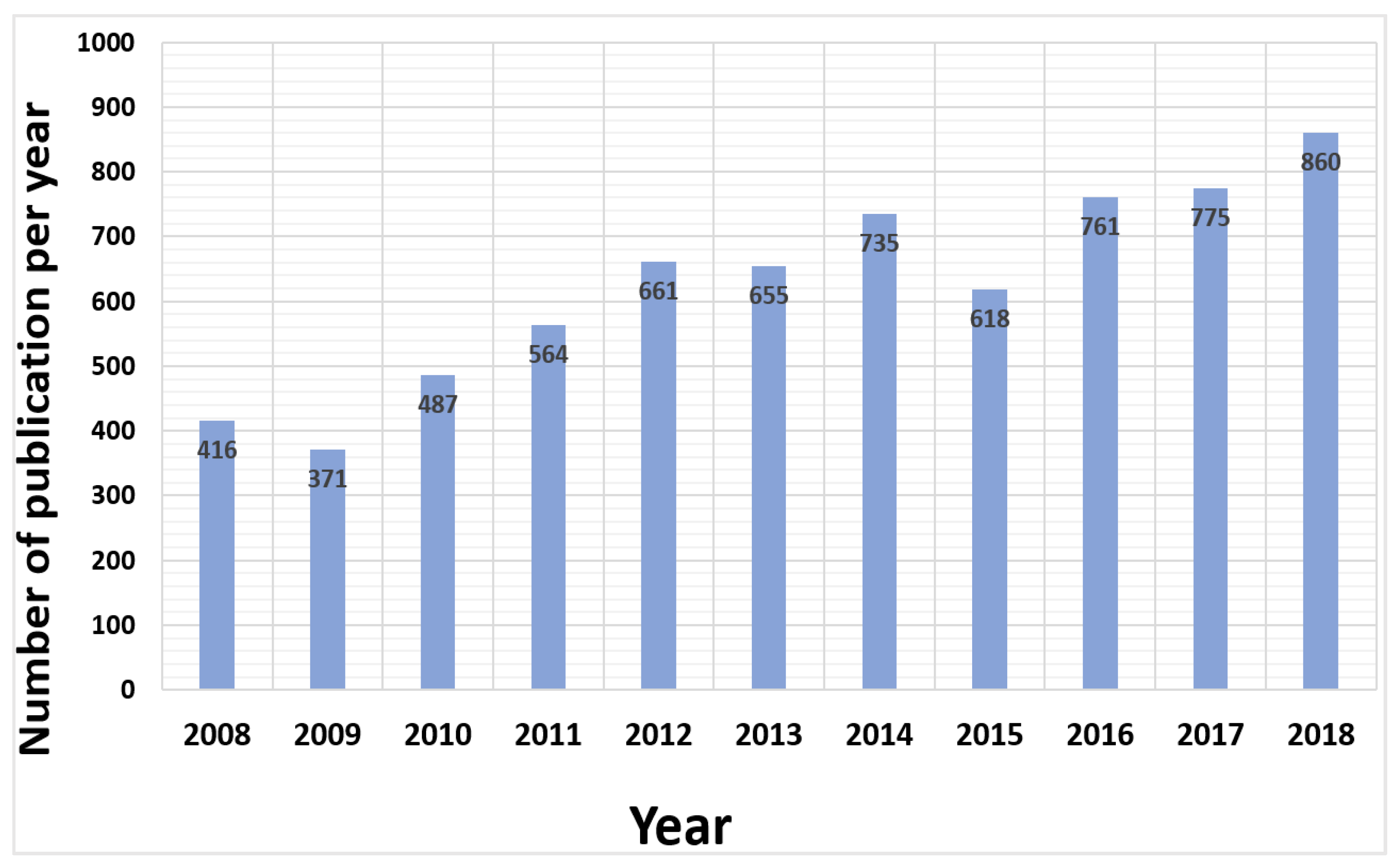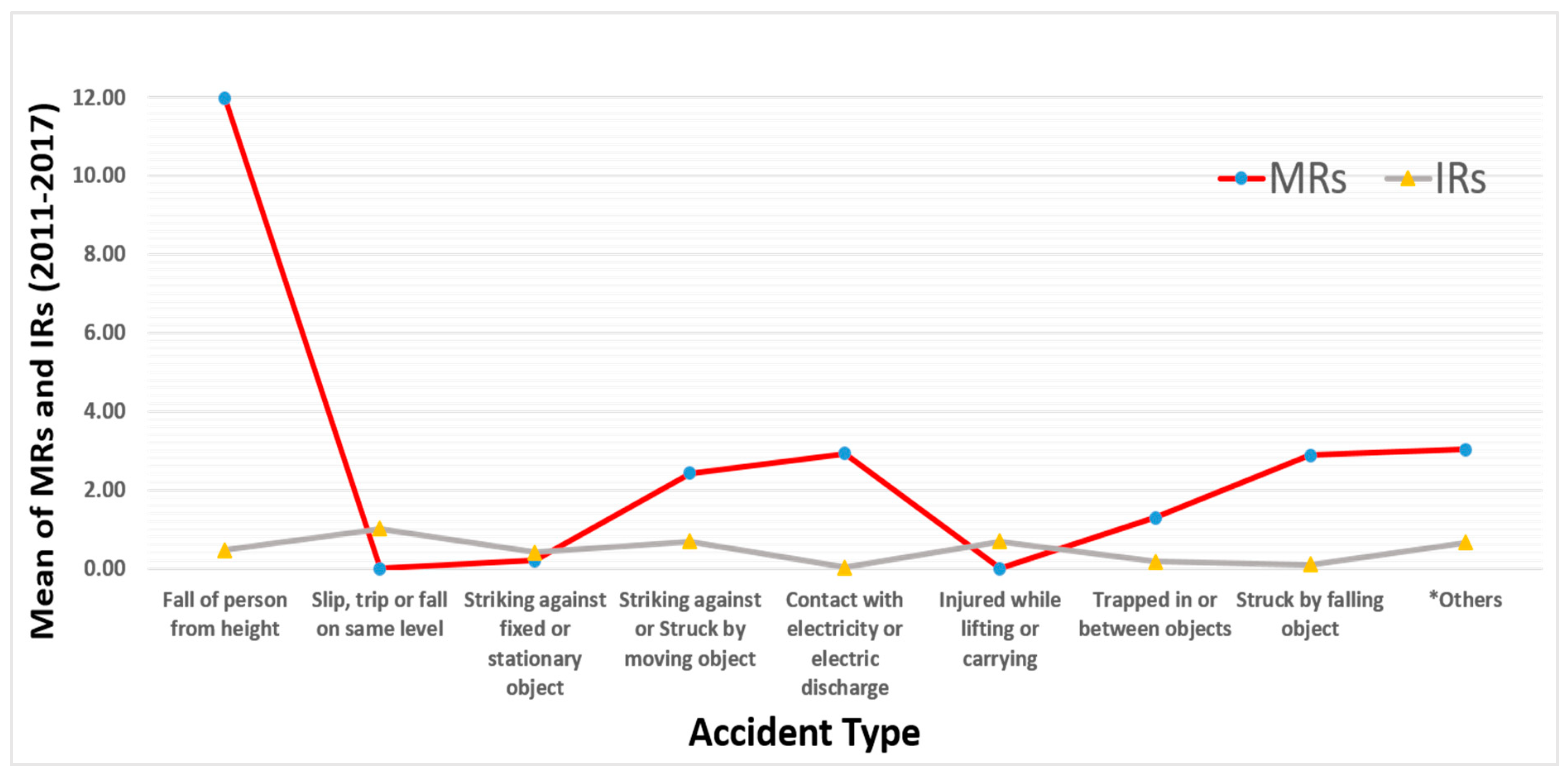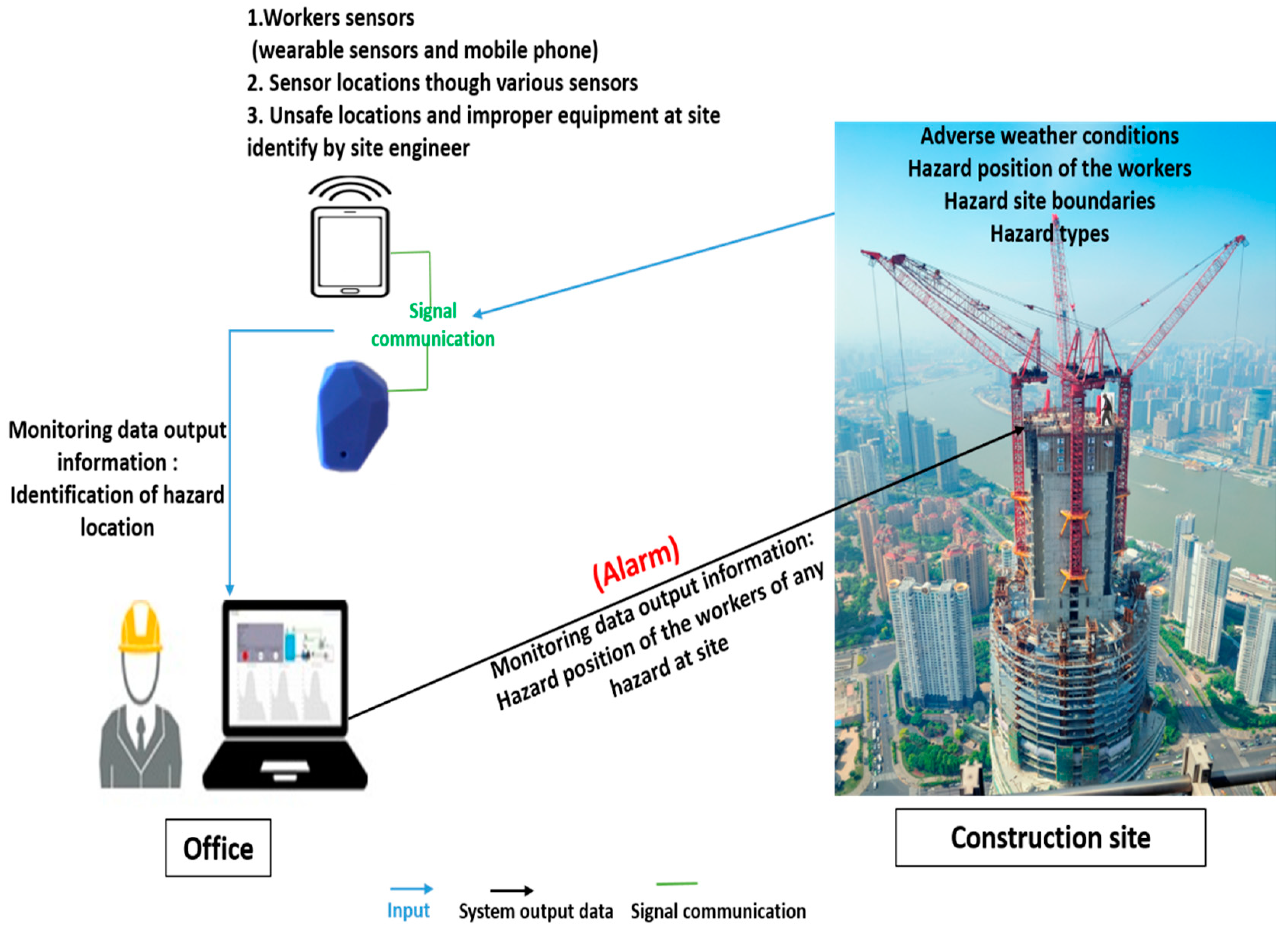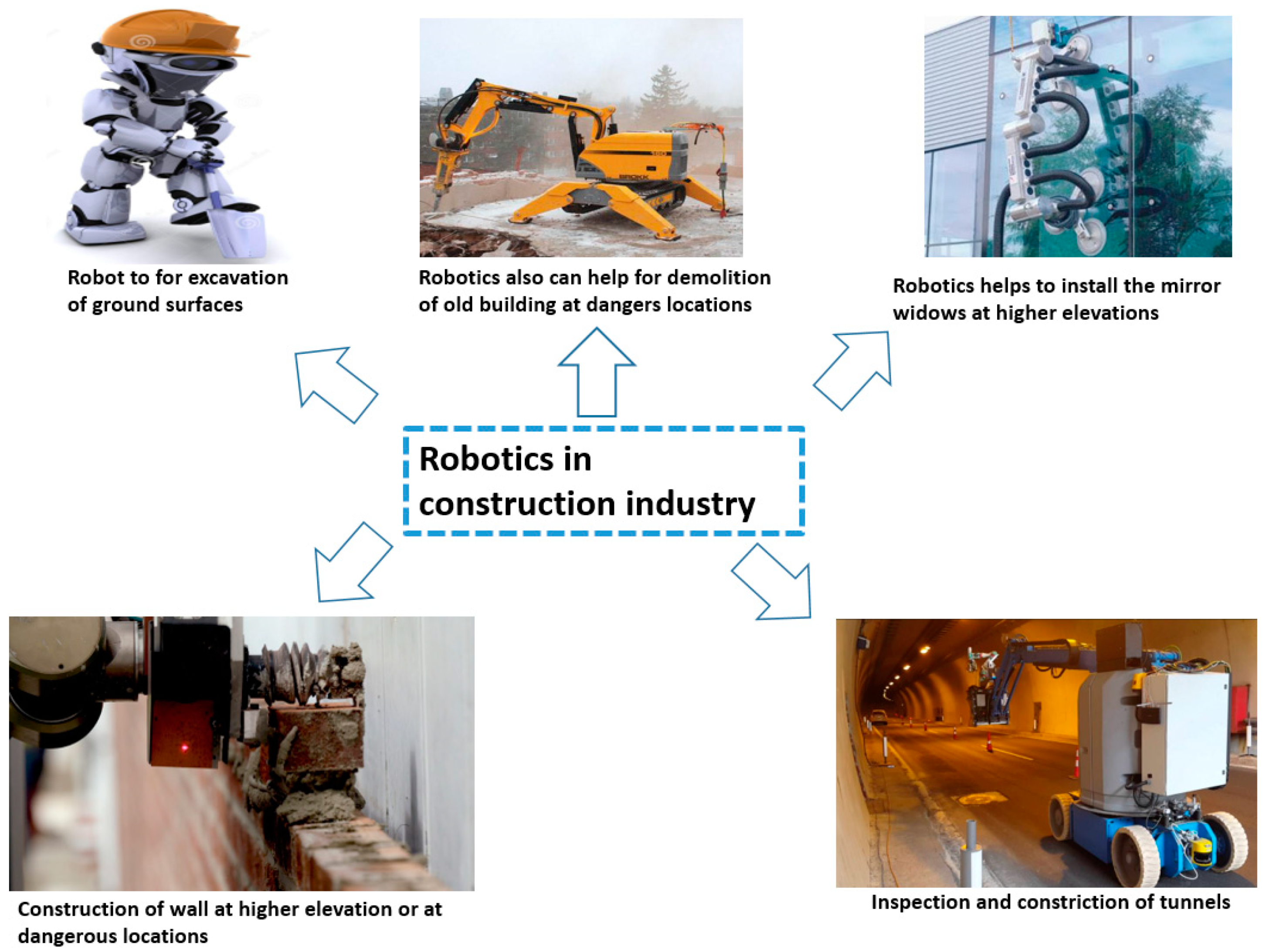An Overview of Construction Occupational Accidents in Hong Kong: A Recent Trend and Future Perspectives
Abstract
1. Introduction
Research Significance and Motivation
2. Methodology
2.1. Data Extraction
2.2. Data Collection and Analysis
3. Results
3.1. Overview of Workers and Occupational Injuries
3.2. Overview of Incidence and Mortality Rates
3.3. Comparison of Mean of Incidence Rates (IRs) and Mortality Rates (MRs) of Each Accident Type
3.4. One-Way Analysis of Variance (ANOVA)
4. Discussion
5. Future Perspectives
5.1. Future Hong Kong Safety Management System(SMS)
5.2. Advance Technologies for Safety Enhancement
6. Conclusions and Limitations
Author Contributions
Conflicts of Interest
References
- United Nations, Department of Economic and Social Affairs, Population Division. World Population Prospects: The 2017 Revision, Key Findings and Advance Tables. Working Paper No. ESA/P/WP/248.2017. Available online: https://esa.un.org/unpd/wpp/Publications/Files/WPP2017_KeyFindings.pdf (accessed on 10 April 2019).
- Bongaarts, J. Human population growth and the demographic transition. Philos. Trans. R. Soc. B Biol. Sci. 2009, 364, 2985–2990. [Google Scholar] [CrossRef] [PubMed]
- Akang, E.E.U.; Kuti, M.A.O.; Osunkoya, A.O.; Komolafe, E.O.; Malomo, A.O.; Shokunbi, M.T.; Amutta, S.B. Pattern of fatal head injuries in Ibadan - A 10 year review. Med. Sci. Law 2002, 42, 160–166. [Google Scholar] [CrossRef] [PubMed]
- Feng, Y.; Zhang, S.; Wu, P. Factors influencing workplace accident costs of building projects. Saf. Sci. 2015, 72, 97–104. [Google Scholar] [CrossRef]
- Mohseni, P.H.; Farshad, A.A.; Mirkazemi, R.; Orak, R.J. Assessment of the living and workplace health and safety conditions of site-resident construction workers in Tehran, Iran. Int. J. Occup. Saf. Ergon. 2015, 21, 568–573. [Google Scholar] [CrossRef] [PubMed]
- Nadhim, E.A.; Hon, C.; Xia, B.; Stewart, I.; Fang, D. Falls from height in the construction industry: A critical review of the scientific literature. Int. J. Environ. Res. Public Health 2016, 13, 638. [Google Scholar] [CrossRef] [PubMed]
- Tao, L.; Wu, C.; Chiang, Y.-H.; Wong, F.K.-W.; Liang, S. Generational Perceptions of Freedom-Related Work Values: Hong Kong’s Implementation of a No-Saturday-Site-Work Policy in Construction. J. Constr. Eng. Manag. 2017, 143, 06017002. [Google Scholar] [CrossRef]
- Sunindijo, R.Y.; Zou, P.X.W. Political Skill for Developing Construction Safety Climate. J. Constr. Eng. Manag. 2011, 138, 605–612. [Google Scholar] [CrossRef]
- Kines, P.; Mikkelsen, K.L. Effects of Firm Size on Risks and Reporting of Elevation Fall Injury in Construction Trades. J. Occup. Environ. Med. 2003, 45, 1074–1078. [Google Scholar] [CrossRef]
- Hanapi, N.M.; Kamal, M.M.M.; Ismail, M.I.; Abdullah, I.A.P. Identifying Root Causes and Mitigation Measures of Construction Fall Accidents. Gading Bus. Manag. J. 2013, 17, 65–79. [Google Scholar]
- Bureau of Labor Statistics, U.S. 2017. Available online: https://www.bls.gov/opub/mlr/2017/home.htm (accessed on 5 March 2019).
- Labour Department. Occupational Safety and Health Statistics: Bulletin Issue No. 18. 2018. Available online: https://www.labour.gov.hk/eng/osh/content10.htm (accessed on 20 Febraury 2019).
- Health and Safety Executive, U.K. Fatal Injuries Arising from Accidents at Work in Great Britain: Headline Results 2017/18 [Online]. 2017. Available online: http://www.hse.gov.uk/statistics/fatals.htm (accessed on 20 December 2018).
- JISHA Japan Industrial Safety and Health Association. OSH Statistics in Japan. 2017. Available online: https://www.jisha.or.jp/english/statistics/accidents_in_detail_2017.html (accessed on 19 December 2018).
- Fabiano, B.; Currò, F.; Reverberi, A.P.; Pastorino, R. A statistical study on temporary work and occupational accidents: Specific risk factors and risk management strategies. Saf. Sci. 2008, 46, 535–544. [Google Scholar] [CrossRef]
- Macedo, A.C.; Silva, I.L. Analysis of occupational accidents in Portugal between 1992 and 2001. Saf. Sci. 2005, 43, 269–286. [Google Scholar] [CrossRef]
- Jackson, S.A.; Loomis, D. Fatal occupational injuries in the North Carolina construction industry, 1978–1994. Appl. Occup. Environ. Hyg. 2002, 17, 27–33. [Google Scholar] [CrossRef] [PubMed]
- Jo, B.W.; Lee, Y.S.; Kim, J.H.; Khan, R.M.A. Trend analysis of construction industrial accidents in Korea from 2011 to 2015. Sustainability 2017, 9, 1297. [Google Scholar] [CrossRef]
- Workplace Safety and Health Institute. Global Estimates of Occupational Accidents and Work-Related Illnesses. 2017. Available online: http://www.icohweb.org/site/images/news/pdf/Report%20Global%20Estimates%20of%20Occupational%20Accidents%20and%20Work-related%20Illnesses%202017%20rev1.pdf (accessed on 20 November 2018).
- Hamid, A.R.A.; Majid, M.Z.A.; Singh, B. Causes of accidents at construction sites. Malaysian J. Civ. Eng. 2008, 20. [Google Scholar] [CrossRef]
- Dėjus, T. Accidents On Construction Sites And Their Reasons. Constr. Technol. Manag. 2012, 20. [Google Scholar] [CrossRef]
- Duff, A.R.; Everett, J.G.; Suraji, A.; Haslam, R.; Gibb, A.; Abdelhamid, T.S.; Hastings, S.; Hide, S. Identifying Root Causes of Construction Accidents. J. Constr. Eng. Manag. 2002, 126, 52–60. [Google Scholar]
- Chan, D.W.M.; Yam, M.C.H.; Chan, A.P.C.; Kwok, A.W.K.; Wong, F.K.W.; Cheung, E.; Lam, E.W.M. Work at Height Fatalities in the Repair, Maintenance, Alteration, and Addition Works. J. Constr. Eng. Manag. 2008, 134, 527–535. [Google Scholar] [CrossRef]
- Choi, S.D.; Guo, L.; Kim, J.; Xiong, S. Comparison of fatal occupational injuries in construction industry in the United States, South Korea, and China. Int. J. Ind. Ergon. 2019, 71, 64–74. [Google Scholar] [CrossRef]
- Chan, D.W.M.; Choi, T.N.Y. Critical analysis of the application of the Safe Working Cycle (SWC): Interview findings from Hong Kong. J. Facil. Manag. 2015, 13, 244–265. [Google Scholar] [CrossRef]
- Chan, D.W.M.; Chan, A.P.C.; Choi, T.N.Y. An empirical survey of the benefits of implementing pay for safety scheme (PFSS) in the Hong Kong construction industry. J. Safety Res. 2010, 41, 433–443. [Google Scholar] [CrossRef]
- Yu, S.C.; Hunt, B. Safety management systems in Hong Kong: is there anything wrong with the implementation? Manag. Audit. J. 2002, 17, 588–592. [Google Scholar] [CrossRef]
- Chiang, Y.-H.; Wong, F.K.-W.; Liang, S. Fatal Construction Accidents in Hong Kong. J. Constr. Eng. Manag. 2017, 144, 04017121. [Google Scholar] [CrossRef]
- Chan, A.P.C.; Hon, C.K.H. Safety of Repair, Maintenance, Minor Alteration, and Addition (RMAA) Works: A New Focus of Construction Safety; Routledge: Abingdon, UK, 2016; ISBN 9781315677378. [Google Scholar]
- Labour Department of Hong Kong Occupational Safety and Health Branch. Available online: https://www.labour.gov.hk/eng/osh/content.htm (accessed on 20 November 2018).
- World Health Organization. Falls: Fact sheet. [WWW Document]. WHO Accessed, Media Cent. 2018. Available online: https://www.who.int/news-room/fact-sheets/detail/falls (accessed on 10 March 2019).
- OSHA Training Institute. Construction Focus Four: Fall Hazards. 2011. Available online: http://oshaedne.com/files/ConstrFocusFourIntroduction_April2011.pdf (accessed on 05 April 2019).
- Amiri, M.; Ardeshir, A.; Fazel Zarandi, M.H. Risk-based Analysis of Construction Accidents in Iran During 2007-2011-Meta Analyze Study. Iran. J. Public Health 2014, 43, 507. [Google Scholar] [PubMed]
- GÜRCANLI, G.E.; MÜNGEN, U. Analysis of Construction Accidents in Turkey and Responsible Parties. Ind. Health 2013, 51, 581–595. [Google Scholar] [CrossRef]
- Hu, K.; Rahmandad, H.; Smith-Jackson, T.; Winchester, W. Factors influencing the risk of falls in the constructionindustry: A review of the evidence. Constr. Manag. Econ. 2011, 29, 397–416. [Google Scholar] [CrossRef]
- BLS Fatal Occupational Injuries by Industry and Event or Exposure. Available online: https://www.bls.gov/news.release/pdf/cfoi.pdf (accessed on 10 March 2019).
- HSE Health and Safety in Construction Sector in Great Britain 2014/15. Available online: file:///C:/Users/shafiq/Downloads/HSE_HealthSafetyStatistics_201415_ConstructionBreakdown.pdf (accessed on 16 December 2018).
- Bureau of Labor Statistics (BLS) April 2017 Monthly Labor Review – an Analysis of Fatal Occupational Injuries at Road Construction Site, 2016–2017. Available online: https://www.bls.gov/news.release/cfoi.t04.htm (accessed on 3 January 2019).
- Labour Department. Code of Practice on Safety Management. Hong Kong: Occupational Safety and Health Branch, Labour Department. 2002. Available online: https://www.labour.gov.hk/eng/public/os/manage.pdf (accessed on 18 February 2019).
- Yiu, N.S.N.; Sze, N.N.; Chan, D.W.M. Implementation of safety management systems in Hong Kong construction industry—A safety practitioner’s perspective. J. Safety Res. 2018, 64, 1–9. [Google Scholar] [CrossRef]
- Yiu, N.S.N.; Chan, D.W.M.; Shan, M.; Sze, N.N. Implementation of safety management system in managing construction projects: Benefits and obstacles. Saf. Sci. 2019, 117, 23–32. [Google Scholar] [CrossRef]
- Choudhry, R.M.; Fang, D.; Ahmed, S.M. Safety Management in Construction: Best Practices in Hong Kong. J. Prof. Issues Eng. Educ. Pract. 2007, 134, 20–32. [Google Scholar] [CrossRef]
- Chen, Q.; García de Soto, B.; Adey, B.T. Construction automation: Research areas, industry concerns and suggestions for advancement. Autom. Constr. 2018, 94, 22–38. [Google Scholar] [CrossRef]
- Lee, W.H.; Tse, K.H.D.; Ma, W.K.P. Applied Technologies in Minimizing Accidents in Construction Industry. Procedia Environ. Sci. 2016, 36, 54–56. [Google Scholar] [CrossRef][Green Version]
- Lu, M.; Chen, W.; Shen, X.; Lam, H.C.; Liu, J. Positioning and tracking construction vehicles in highly dense urban areas and building construction sites. Autom. Constr. 2007, 16, 647–656. [Google Scholar] [CrossRef]
- Gu, Y.; Lo, A.; Niemegeers, I. A survey of indoor positioning systems for wireless personal networks. IEEE Commun. Surv. Tutorials 2009, 11, 2009. [Google Scholar] [CrossRef]
- Maalek, R.; Sadeghpour, F. Accuracy assessment of Ultra-Wide Band technology in tracking static resources in indoor construction scenarios. Autom. Constr. 2013, 30, 170–183. [Google Scholar] [CrossRef]
- Khoury, H.M.; Kamat, V.R. Evaluation of position tracking technologies for user localization in indoor construction environments. Autom. Constr. 2009, 18, 444–457. [Google Scholar] [CrossRef]
- Lee, W.; Lin, K.Y.; Seto, E.; Migliaccio, G.C. Wearable sensors for monitoring on-duty and off-duty worker physiological status and activities in construction. Autom. Constr. 2017, 83, 341–353. [Google Scholar] [CrossRef]
- Cheng, T.; Teizer, J. Real-time resource location data collection and visualization technology for construction safety and activity monitoring applications. Autom. Constr. 2013, 34, 3–15. [Google Scholar] [CrossRef]
- Awolusi, I.; Marks, E.; Hallowell, M. Wearable technology for personalized construction safety monitoring and trending: Review of applicable devices. Autom. Constr. 2018, 85, 96–106. [Google Scholar] [CrossRef]
- Guo, H.; Yu, Y.; Skitmore, M. Visualization technology-based construction safety management: A review. Autom. Constr. 2017, 73, 135–144. [Google Scholar] [CrossRef]
- Luo, H.; Xiong, C.; Fang, W.; Love, P.E.D.; Zhang, B.; Ouyang, X. Convolutional neural networks: Computer vision-based workforce activity assessment in construction. Autom. Constr. 2018, 94, 282–289. [Google Scholar] [CrossRef]
- Feng, C.; Kamat, V.R.; Cai, H. Camera marker networks for articulated machine pose estimation. Autom. Constr. 2018, 96, 148–160. [Google Scholar] [CrossRef]
- Helwa, M.K.; Schoellig, A.P. On the construction of safe controllable regions for affine systems with applications to robotics. Automatica 2018, 98, 323–330. [Google Scholar] [CrossRef]
- Chen, J.; Wang, J.; Xiao, Q.; Chen, C. A Multi-Robot Task Allocation Method Based on Multi-Objective Optimization. In Proceedings of the 15th International Conference on Control, Automation, Robotics and Vision, ICARCV 2018, Singapore, 18–21 November 2018; Institute of Electrical and Electronics Engineers Inc.: Zhaoqing University, School of Computer Science and Software, Zhaoqing, Guangdong, China, 2018; pp. 1868–1873. [Google Scholar]
- Menendez, E.; Victores, J.G.; Montero, R.; Balaguer, C. Autonomous Robotic System with Tunnel Inspection Tool Positioning. In Proceedings of the 34th International Symposium on Automation and Robotics in Construction (ISARC), Taipei, Taiwan, 28 June–1 July 2017; Vilnius Gediminas Technical University: Vilnius, Lithuania, 2017. [Google Scholar]
- King, N.; Bechthold, M.; Kane, A.; Michalatos, P. Robotic tile placement: Tools, techniques and feasibility. Autom. Constr. 2014, 39, 161–166. [Google Scholar] [CrossRef]
- You, S.; Kim, J.-H.; Lee, S.; Kamat, V.; Robert, L.P., Jr. Enhancing perceived safety in human–robot collaborative construction using immersive virtual environments. Autom. Constr. 2018, 96, 161–170. [Google Scholar] [CrossRef]
- Hide, S.; Atkinson, S.; Pavitt, T.C.; Haslam, R.; Gibb, A.G.; Gyi, D.E. Causal Factors in Construction Accidents; HSE research report 156; Health and Safety Executive: Bootle, UK, 2003; ISBN 0717627497. [Google Scholar]
- Sawacha, E.; Naoum, S.; Fong, D. Factors affecting safety performance on construction sites. Int. J. Proj. Manag. 1999, 17, 309–315. [Google Scholar] [CrossRef]
- Khosravi, Y.; Asilian-Mahabadi, H.; Hajizadeh, E.; Hassanzadeh-Rangi, N.; Bastani, H.; Behzadan, A.H. Factors influencing unsafe behaviors and accidents on construction sites: A review. Int. J. Occup. Saf. Ergon. 2014, 20, 111–125. [Google Scholar] [CrossRef]
- Zou, Y.; Kiviniemi, A.; Jones, S.W. A review of risk management through BIM and BIM-related technologies. Saf. Sci. 2017, 97, 88–98. [Google Scholar] [CrossRef]
- Zhang, S.; Teizer, J.; Lee, J.K.; Eastman, C.M.; Venugopal, M. Building Information Modeling (BIM) and Safety: Automatic Safety Checking of Construction Models and Schedules. Autom. Constr. 2013, 29, 183–195. [Google Scholar] [CrossRef]
- Wetzel, E.M.; Thabet, W.Y. The use of a BIM-based framework to support safe facility management processes. Autom. Constr. 2015, 60, 12–24. [Google Scholar] [CrossRef]




| Year | Workers (n) | Occupational Injuries (OIs) | Fatal Occupational Injuries (FOIs) | ||
|---|---|---|---|---|---|
| Number (n) | IRs | Number (n) | MRs | ||
| 2011 | 62,635 | 3188 | 5.1 | 23 | 36.7 |
| 2012 | 71,295 | 3252 | 4.6 | 24 | 33.7 |
| 2013 | 79,303 | 3332 | 4.2 | 22 | 27.7 |
| 2014 | 82,795 | 3573 | 4.3 | 20 | 24.2 |
| 2015 | 95,103 | 3863 | 4.1 | 19 | 19.9 |
| 2016 | 107,799 | 3860 | 3.6 | 10 | 9.27 |
| 2017 | 118,674 | 4114 | 3.5 | 22 | 18.5 |
| Mean | 88,229 | 3597 | - | 20 | - |
| Accidents Types | OIs | FOIs | ||||||||||||
|---|---|---|---|---|---|---|---|---|---|---|---|---|---|---|
| 2011 | 2012 | 2013 | 2014 | 2015 | 2016 | 2017 | 2011 | 2012 | 2013 | 2014 | 2015 | 2016 | 2017 | |
| Fall of person from height | 390 | 429 | 439 | 374 | 380 | 351 | 381 | 10 | 12 | 15 | 7 | 9 | 7 | 9 |
| Slip, trip or fall on same level | 649 | 738 | 801 | 882 | 950 | 1057 | 1086 | 0 | 0 | 0 | 0 | 0 | 0 | 0 |
| Striking against fixed or stationary object | 280 | 295 | 311 | 390 | 382 | 392 | 447 | 0 | 1 | 0 | 0 | 0 | 0 | 0 |
| Striking against or struck by moving object | 522 | 551 | 612 | 646 | 584 | 586 | 549 | 3 | 2 | 2 | 2 | 1 | 1 | 3 |
| Contact with electricity or electric discharge | 6 | 17 | 10 | 12 | 8 | 7 | 9 | 2 | 7 | 0 | 2 | 3 | 2 | 0 |
| Injured while lifting or carrying | 606 | 525 | 490 | 453 | 677 | 626 | 724 | 0 | 0 | 0 | 0 | 0 | 0 | 0 |
| Trapped in or between objects | 106 | 114 | 137 | 205 | 160 | 158 | 147 | 1 | 1 | 0 | 2 | 1 | 0 | 3 |
| Struck by falling object | 73 | 56 | 50 | 68 | 110 | 111 | 113 | 3 | 2 | 2 | 5 | 3 | 0 | 1 |
| * Others | 556 | 527 | 482 | 543 | 612 | 572 | 658 | 4 | 1 | 3 | 2 | 2 | 0 | 6 |
| Accidents Types | IRs | MRs | ||||||||||||
|---|---|---|---|---|---|---|---|---|---|---|---|---|---|---|
| 2011 | 2012 | 2013 | 2014 | 2015 | 2016 | 2017 | 2011 | 2012 | 2013 | 2014 | 2015 | 2016 | 2017 | |
| Fall of person from height | 0.62 | 0.60 | 0.55 | 0.45 | 0.40 | 0.33 | 0.32 | 15.97 | 16.83 | 18.91 | 8.45 | 9.46 | 6.49 | 7.58 |
| Slip, trip or fall on same level | 1.04 | 1.04 | 1.01 | 1.07 | 1.00 | 0.98 | 0.92 | 0 | 0 | 0 | 0 | 0 | 0 | 0 |
| Striking against fixed or stationary object | 0.45 | 0.41 | 0.39 | 0.47 | 0.40 | 0.36 | 0.38 | 0 | 1.40 | 0 | 0 | 0 | 0 | 0 |
| Striking against or struck by moving object | 0.83 | 0.77 | 0.77 | 0.78 | 0.61 | 0.54 | 0.46 | 4.79 | 2.81 | 2.52 | 2.42 | 1.05 | 0.93 | 2.53 |
| Contact with electricity or electric discharge | 0.01 | 0.02 | 0.01 | 0.01 | 0.01 | 0.01 | 0.01 | 3.19 | 9.82 | 0 | 2.42 | 3.15 | 1.86 | 0 |
| Injured while lifting or carrying | 0.97 | 0.74 | 0.62 | 0.55 | 0.71 | 0.58 | 0.61 | 0 | 0 | 0 | 0 | 0 | 0 | 0 |
| Trapped in or between objects | 0.17 | 0.16 | 0.17 | 0.25 | 0.17 | 0.15 | 0.12 | 1.60 | 1.40 | 0 | 2.42 | 1.05 | 0 | 2.53 |
| Struck by falling object | 0.12 | 0.08 | 0.06 | 0.08 | 0.12 | 0.10 | 0.10 | 4.79 | 2.81 | 2.52 | 6.04 | 3.15 | 0 | 0.84 |
| * Others | 0.89 | 0.74 | 0.61 | 0.66 | 0.64 | 0.53 | 0.55 | 6.39 | 1.40 | 3.78 | 2.42 | 2.10 | 0 | 5.06 |
| Accidents Type (F = 87.566, p < 0.001) | |||||||||||
|---|---|---|---|---|---|---|---|---|---|---|---|
| Accident Type | Mean (SD±) | 1 | 2 | 3 | 4 | 5 | 6 | 7 | 8 | 9 | |
| 1 | Fall of person from height | 0.468 (0.126) | *** | ns | *** | *** | *** | *** | *** | *** | |
| 2 | Slip, trip or fall on same level | 1.004 (0.049) | *** | *** | *** | *** | *** | *** | *** | *** | |
| 3 | Striking against fixed or stationary object | 0.409 (0.038) | ns | *** | *** | *** | *** | *** | *** | *** | |
| 4 | Striking against or Struck by moving object | 0.683 (0.142) | *** | *** | *** | *** | ns | *** | *** | ns | |
| 5 | Contact with electricity or electric discharge | 0.012 (0.006) | *** | *** | *** | *** | *** | ** | ns | *** | |
| 6 | Injured while lifting or carrying | 0.682 (0.143) | *** | *** | *** | ns | *** | *** | *** | ns | |
| 7 | Trapped in or between objects | 0.169 (0.038) | *** | *** | *** | *** | ** | *** | ns | *** | |
| 8 | Struck by falling object | 0.093 (0.019) | *** | *** | *** | *** | ns | *** | ns | *** | |
| 9 | * Others | 0.659 (0.122) | *** | *** | *** | ns | *** | ns | *** | *** | |
| Accident Type | Accidents Type (F = 17.423, p < 0.001) | ||||||||||
|---|---|---|---|---|---|---|---|---|---|---|---|
| Mean (SD±) | 1 | 2 | 3 | 4 | 5 | 6 | 7 | 8 | 9 | ||
| 1 | Fall of person from height | 11.959 (5.094) | *** | *** | *** | *** | *** | *** | *** | *** | |
| 2 | Slip, trip or fall on same level | 0.0000 | *** | ns | ns | * | ns | ns | * | * | |
| 3 | Striking against fixed or stationary object | 0.201 (0.530) | *** | ns | ns | * | ns | ns | * | * | |
| 4 | Striking against or Struck by moving object | 2.434 (1.283) | *** | ns | ns | ns | ns | ns | ns | ns | |
| 5 | Contact with electricity or electric discharge | 2.919 (3.321) | *** | * | * | ns | * | ns | ns | ns | |
| 6 | Injured while lifting or carrying | 0.0000 | *** | ns | ns | ns | * | ns | * | * | |
| 7 | Trapped in or between objects | 1.285 (1.024) | *** | ns | ns | ns | ns | ns | ns | ns | |
| 8 | Struck by falling object | 2.879 (2.093) | *** | * | * | ns | ns | * | ns | ns | |
| 9 | Others | 3.021 (2.199) | *** | * | * | ns | ns | * | ns | ns | |
© 2019 by the authors. Licensee MDPI, Basel, Switzerland. This article is an open access article distributed under the terms and conditions of the Creative Commons Attribution (CC BY) license (http://creativecommons.org/licenses/by/4.0/).
Share and Cite
Shafique, M.; Rafiq, M. An Overview of Construction Occupational Accidents in Hong Kong: A Recent Trend and Future Perspectives. Appl. Sci. 2019, 9, 2069. https://doi.org/10.3390/app9102069
Shafique M, Rafiq M. An Overview of Construction Occupational Accidents in Hong Kong: A Recent Trend and Future Perspectives. Applied Sciences. 2019; 9(10):2069. https://doi.org/10.3390/app9102069
Chicago/Turabian StyleShafique, Muhammad, and Muhammad Rafiq. 2019. "An Overview of Construction Occupational Accidents in Hong Kong: A Recent Trend and Future Perspectives" Applied Sciences 9, no. 10: 2069. https://doi.org/10.3390/app9102069
APA StyleShafique, M., & Rafiq, M. (2019). An Overview of Construction Occupational Accidents in Hong Kong: A Recent Trend and Future Perspectives. Applied Sciences, 9(10), 2069. https://doi.org/10.3390/app9102069






